The Aim of Education in Schools: A Comprehensive Overview
VerifiedAdded on 2022/08/29
|6
|1982
|25
Essay
AI Summary
This essay delves into the multifaceted aim of education, emphasizing its role in fostering student skills, knowledge, and career readiness. It highlights the importance of education in enhancing values, beliefs, and skills, promoting harmony and equality. The essay explores the influence of parents and the state in shaping education, including the impact of family background, cultural factors, and state policies. It further examines various learning approaches, advocating for curricula that promote problem-solving, critical thinking, and overall student development. The essay also discusses the economic participation of education, emphasizing how education prepares individuals for employment, contributes to economic growth, and fosters innovation and productivity. The conclusion underscores the need for a learning-based approach, effective teaching practices, and a curriculum that integrates cognitive understanding, social responsibility, and national liability, ultimately leading to increased job opportunities and economic participation for students.
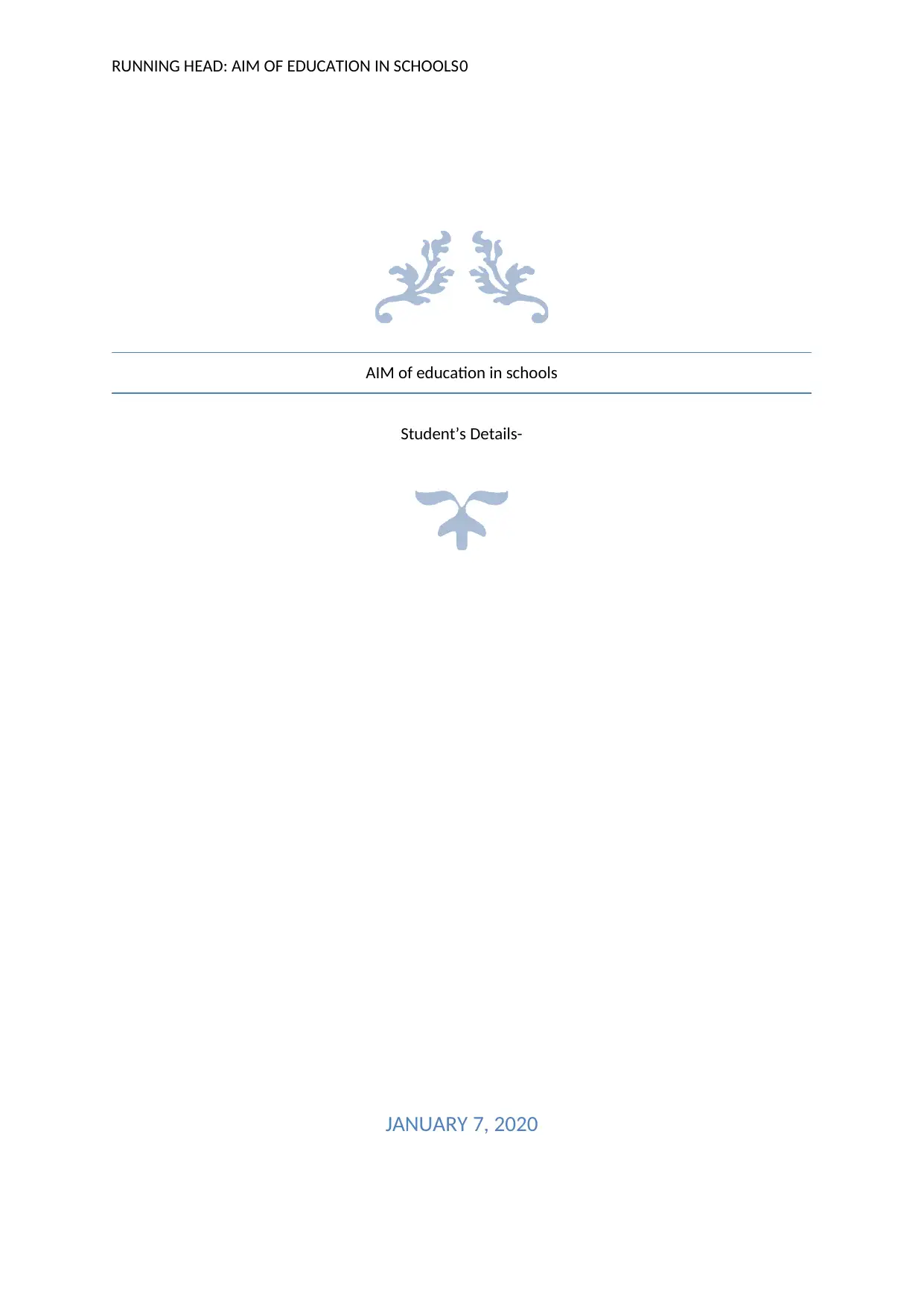
RUNNING HEAD: AIM OF EDUCATION IN SCHOOLS0
AIM of education in schools
Student’s Details-
JANUARY 7, 2020
AIM of education in schools
Student’s Details-
JANUARY 7, 2020
Paraphrase This Document
Need a fresh take? Get an instant paraphrase of this document with our AI Paraphraser
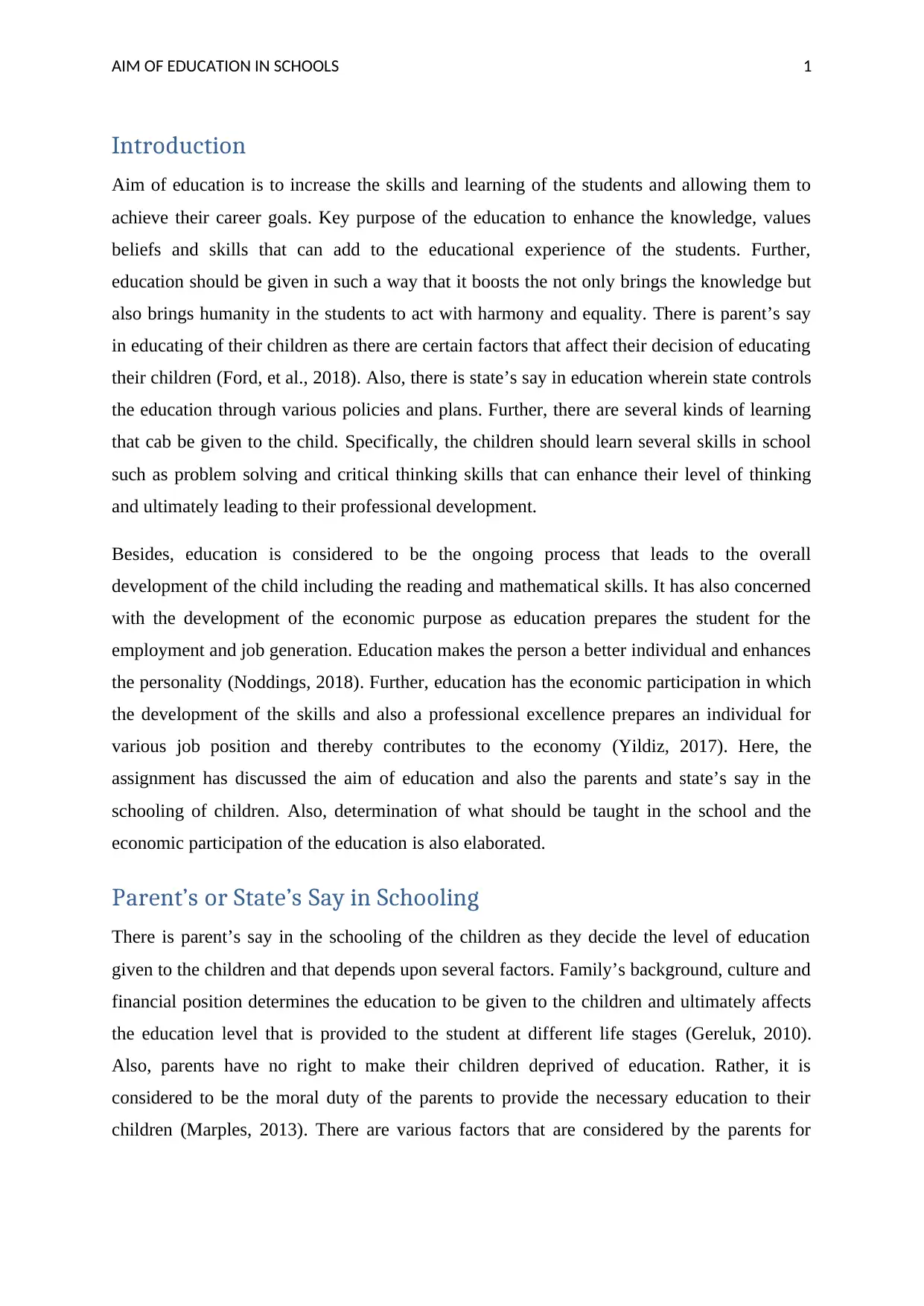
AIM OF EDUCATION IN SCHOOLS 1
Introduction
Aim of education is to increase the skills and learning of the students and allowing them to
achieve their career goals. Key purpose of the education to enhance the knowledge, values
beliefs and skills that can add to the educational experience of the students. Further,
education should be given in such a way that it boosts the not only brings the knowledge but
also brings humanity in the students to act with harmony and equality. There is parent’s say
in educating of their children as there are certain factors that affect their decision of educating
their children (Ford, et al., 2018). Also, there is state’s say in education wherein state controls
the education through various policies and plans. Further, there are several kinds of learning
that cab be given to the child. Specifically, the children should learn several skills in school
such as problem solving and critical thinking skills that can enhance their level of thinking
and ultimately leading to their professional development.
Besides, education is considered to be the ongoing process that leads to the overall
development of the child including the reading and mathematical skills. It has also concerned
with the development of the economic purpose as education prepares the student for the
employment and job generation. Education makes the person a better individual and enhances
the personality (Noddings, 2018). Further, education has the economic participation in which
the development of the skills and also a professional excellence prepares an individual for
various job position and thereby contributes to the economy (Yildiz, 2017). Here, the
assignment has discussed the aim of education and also the parents and state’s say in the
schooling of children. Also, determination of what should be taught in the school and the
economic participation of the education is also elaborated.
Parent’s or State’s Say in Schooling
There is parent’s say in the schooling of the children as they decide the level of education
given to the children and that depends upon several factors. Family’s background, culture and
financial position determines the education to be given to the children and ultimately affects
the education level that is provided to the student at different life stages (Gereluk, 2010).
Also, parents have no right to make their children deprived of education. Rather, it is
considered to be the moral duty of the parents to provide the necessary education to their
children (Marples, 2013). There are various factors that are considered by the parents for
Introduction
Aim of education is to increase the skills and learning of the students and allowing them to
achieve their career goals. Key purpose of the education to enhance the knowledge, values
beliefs and skills that can add to the educational experience of the students. Further,
education should be given in such a way that it boosts the not only brings the knowledge but
also brings humanity in the students to act with harmony and equality. There is parent’s say
in educating of their children as there are certain factors that affect their decision of educating
their children (Ford, et al., 2018). Also, there is state’s say in education wherein state controls
the education through various policies and plans. Further, there are several kinds of learning
that cab be given to the child. Specifically, the children should learn several skills in school
such as problem solving and critical thinking skills that can enhance their level of thinking
and ultimately leading to their professional development.
Besides, education is considered to be the ongoing process that leads to the overall
development of the child including the reading and mathematical skills. It has also concerned
with the development of the economic purpose as education prepares the student for the
employment and job generation. Education makes the person a better individual and enhances
the personality (Noddings, 2018). Further, education has the economic participation in which
the development of the skills and also a professional excellence prepares an individual for
various job position and thereby contributes to the economy (Yildiz, 2017). Here, the
assignment has discussed the aim of education and also the parents and state’s say in the
schooling of children. Also, determination of what should be taught in the school and the
economic participation of the education is also elaborated.
Parent’s or State’s Say in Schooling
There is parent’s say in the schooling of the children as they decide the level of education
given to the children and that depends upon several factors. Family’s background, culture and
financial position determines the education to be given to the children and ultimately affects
the education level that is provided to the student at different life stages (Gereluk, 2010).
Also, parents have no right to make their children deprived of education. Rather, it is
considered to be the moral duty of the parents to provide the necessary education to their
children (Marples, 2013). There are various factors that are considered by the parents for

AIM OF EDUCATION IN SCHOOLS 2
educating the child. Particularly, the fact that children must be able to brought up their
careers by themselves and ensuring that the child’s interest and needs are particularly met.
Further, state has a say in schooling of children in which state has made the several policies
and the rules for controlling the education. Moreover, state has the main responsibility to
maintain and operate the public schools (Suissa, 2010). The roles of federal and state
government are to include the provisions for the development of educational curriculum that
defines the style of learning to be given to the students and the courses and the studies that
are needed to be added (Lawler, 2016). State controls the education through the use of
educational policy in which the state provides the resources for the schools through the
facilitation of the curriculum, teaching methods and the instructional materials along with the
several policies and the standards for the maintaining the quality of education which is being
provided in the schools.
Learning in School
Learning in the school should be in such a way that it adds to the knowledge and skills of the
students and leads to the overall development of the child. Schools must adopt the curriculum
that adds to the skills of students such as problem solving and analytical skills that can make
them more creative and innovative (Hand , 2010). Rather than the academic results, schools
must emphasis on the learning process that can make them more confident. Further, the
schools must focus on the aim-based curriculum that can add to the overall development of
the students (Reiss, 2014). Curriculum of the education is expected to be specific in terms of
goals and also be helpful in adding to the educational level of the students and making them
more reliable on the learning rather than academic excellence. It is also being ensured that
students receive the coherent learning experiences and also have an integrated purpose of
development that can add to their personal and professional development.
Learning in the schools greatly depends upon the teaching practice to be used by the teachers
which includes the significant ways by which the teachers make collaborations with the
students and add to their learning as a student (Alsubaie, 2016). Specifically, teachers must
be communicative to the children in order to solve the queries of the students throughout the
semester. Further, teachers must ensure the active participation of the students through
encouraging the interactions. Apart from this, learning in the schools must focus on the
cognitive functionality of the students that can enhance their analytical and critical thinking
skills that can contribute to the learning process of the students. Learning should be used in a
educating the child. Particularly, the fact that children must be able to brought up their
careers by themselves and ensuring that the child’s interest and needs are particularly met.
Further, state has a say in schooling of children in which state has made the several policies
and the rules for controlling the education. Moreover, state has the main responsibility to
maintain and operate the public schools (Suissa, 2010). The roles of federal and state
government are to include the provisions for the development of educational curriculum that
defines the style of learning to be given to the students and the courses and the studies that
are needed to be added (Lawler, 2016). State controls the education through the use of
educational policy in which the state provides the resources for the schools through the
facilitation of the curriculum, teaching methods and the instructional materials along with the
several policies and the standards for the maintaining the quality of education which is being
provided in the schools.
Learning in School
Learning in the school should be in such a way that it adds to the knowledge and skills of the
students and leads to the overall development of the child. Schools must adopt the curriculum
that adds to the skills of students such as problem solving and analytical skills that can make
them more creative and innovative (Hand , 2010). Rather than the academic results, schools
must emphasis on the learning process that can make them more confident. Further, the
schools must focus on the aim-based curriculum that can add to the overall development of
the students (Reiss, 2014). Curriculum of the education is expected to be specific in terms of
goals and also be helpful in adding to the educational level of the students and making them
more reliable on the learning rather than academic excellence. It is also being ensured that
students receive the coherent learning experiences and also have an integrated purpose of
development that can add to their personal and professional development.
Learning in the schools greatly depends upon the teaching practice to be used by the teachers
which includes the significant ways by which the teachers make collaborations with the
students and add to their learning as a student (Alsubaie, 2016). Specifically, teachers must
be communicative to the children in order to solve the queries of the students throughout the
semester. Further, teachers must ensure the active participation of the students through
encouraging the interactions. Apart from this, learning in the schools must focus on the
cognitive functionality of the students that can enhance their analytical and critical thinking
skills that can contribute to the learning process of the students. Learning should be used in a
You're viewing a preview
Unlock full access by subscribing today!
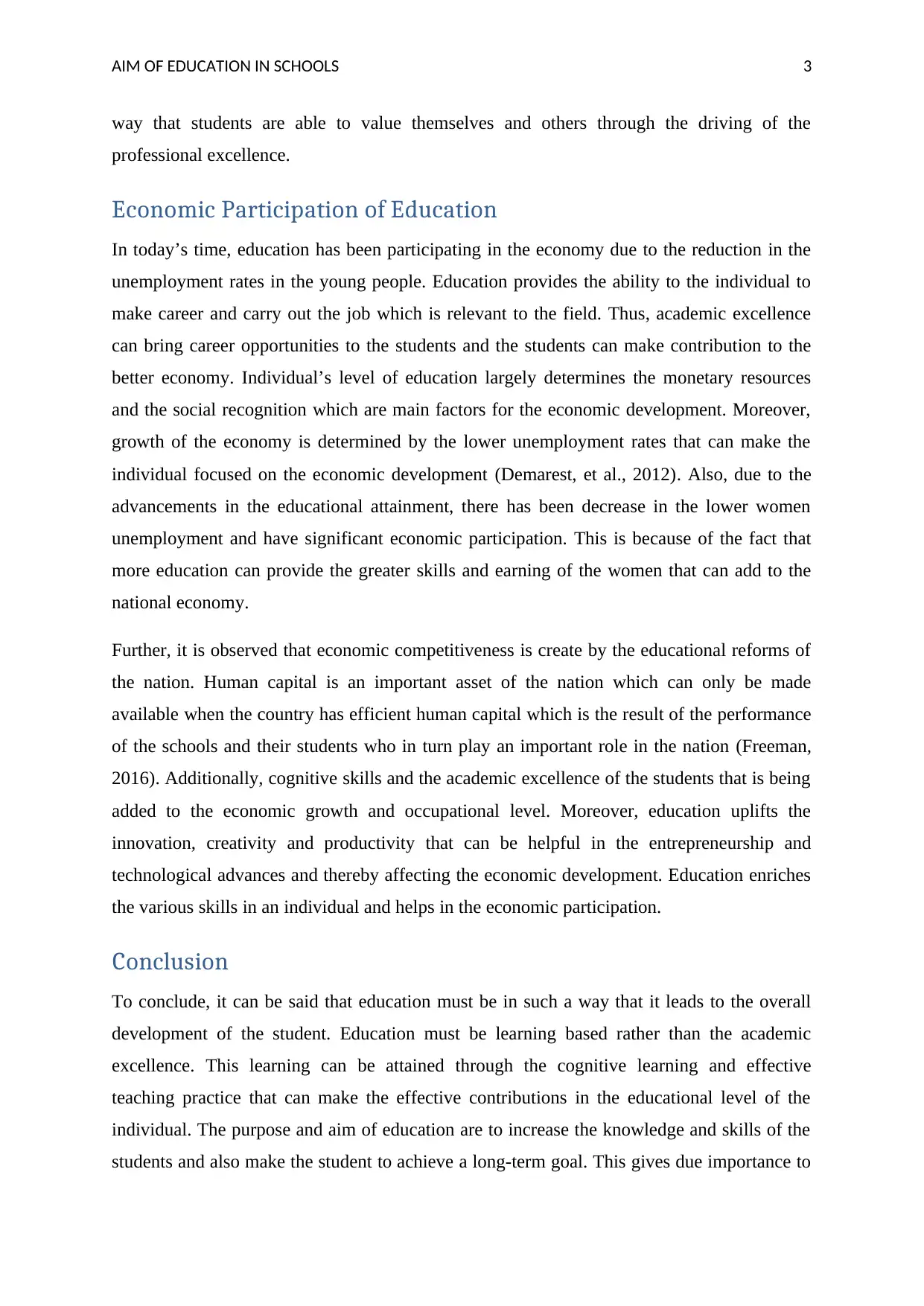
AIM OF EDUCATION IN SCHOOLS 3
way that students are able to value themselves and others through the driving of the
professional excellence.
Economic Participation of Education
In today’s time, education has been participating in the economy due to the reduction in the
unemployment rates in the young people. Education provides the ability to the individual to
make career and carry out the job which is relevant to the field. Thus, academic excellence
can bring career opportunities to the students and the students can make contribution to the
better economy. Individual’s level of education largely determines the monetary resources
and the social recognition which are main factors for the economic development. Moreover,
growth of the economy is determined by the lower unemployment rates that can make the
individual focused on the economic development (Demarest, et al., 2012). Also, due to the
advancements in the educational attainment, there has been decrease in the lower women
unemployment and have significant economic participation. This is because of the fact that
more education can provide the greater skills and earning of the women that can add to the
national economy.
Further, it is observed that economic competitiveness is create by the educational reforms of
the nation. Human capital is an important asset of the nation which can only be made
available when the country has efficient human capital which is the result of the performance
of the schools and their students who in turn play an important role in the nation (Freeman,
2016). Additionally, cognitive skills and the academic excellence of the students that is being
added to the economic growth and occupational level. Moreover, education uplifts the
innovation, creativity and productivity that can be helpful in the entrepreneurship and
technological advances and thereby affecting the economic development. Education enriches
the various skills in an individual and helps in the economic participation.
Conclusion
To conclude, it can be said that education must be in such a way that it leads to the overall
development of the student. Education must be learning based rather than the academic
excellence. This learning can be attained through the cognitive learning and effective
teaching practice that can make the effective contributions in the educational level of the
individual. The purpose and aim of education are to increase the knowledge and skills of the
students and also make the student to achieve a long-term goal. This gives due importance to
way that students are able to value themselves and others through the driving of the
professional excellence.
Economic Participation of Education
In today’s time, education has been participating in the economy due to the reduction in the
unemployment rates in the young people. Education provides the ability to the individual to
make career and carry out the job which is relevant to the field. Thus, academic excellence
can bring career opportunities to the students and the students can make contribution to the
better economy. Individual’s level of education largely determines the monetary resources
and the social recognition which are main factors for the economic development. Moreover,
growth of the economy is determined by the lower unemployment rates that can make the
individual focused on the economic development (Demarest, et al., 2012). Also, due to the
advancements in the educational attainment, there has been decrease in the lower women
unemployment and have significant economic participation. This is because of the fact that
more education can provide the greater skills and earning of the women that can add to the
national economy.
Further, it is observed that economic competitiveness is create by the educational reforms of
the nation. Human capital is an important asset of the nation which can only be made
available when the country has efficient human capital which is the result of the performance
of the schools and their students who in turn play an important role in the nation (Freeman,
2016). Additionally, cognitive skills and the academic excellence of the students that is being
added to the economic growth and occupational level. Moreover, education uplifts the
innovation, creativity and productivity that can be helpful in the entrepreneurship and
technological advances and thereby affecting the economic development. Education enriches
the various skills in an individual and helps in the economic participation.
Conclusion
To conclude, it can be said that education must be in such a way that it leads to the overall
development of the student. Education must be learning based rather than the academic
excellence. This learning can be attained through the cognitive learning and effective
teaching practice that can make the effective contributions in the educational level of the
individual. The purpose and aim of education are to increase the knowledge and skills of the
students and also make the student to achieve a long-term goal. This gives due importance to
Paraphrase This Document
Need a fresh take? Get an instant paraphrase of this document with our AI Paraphraser
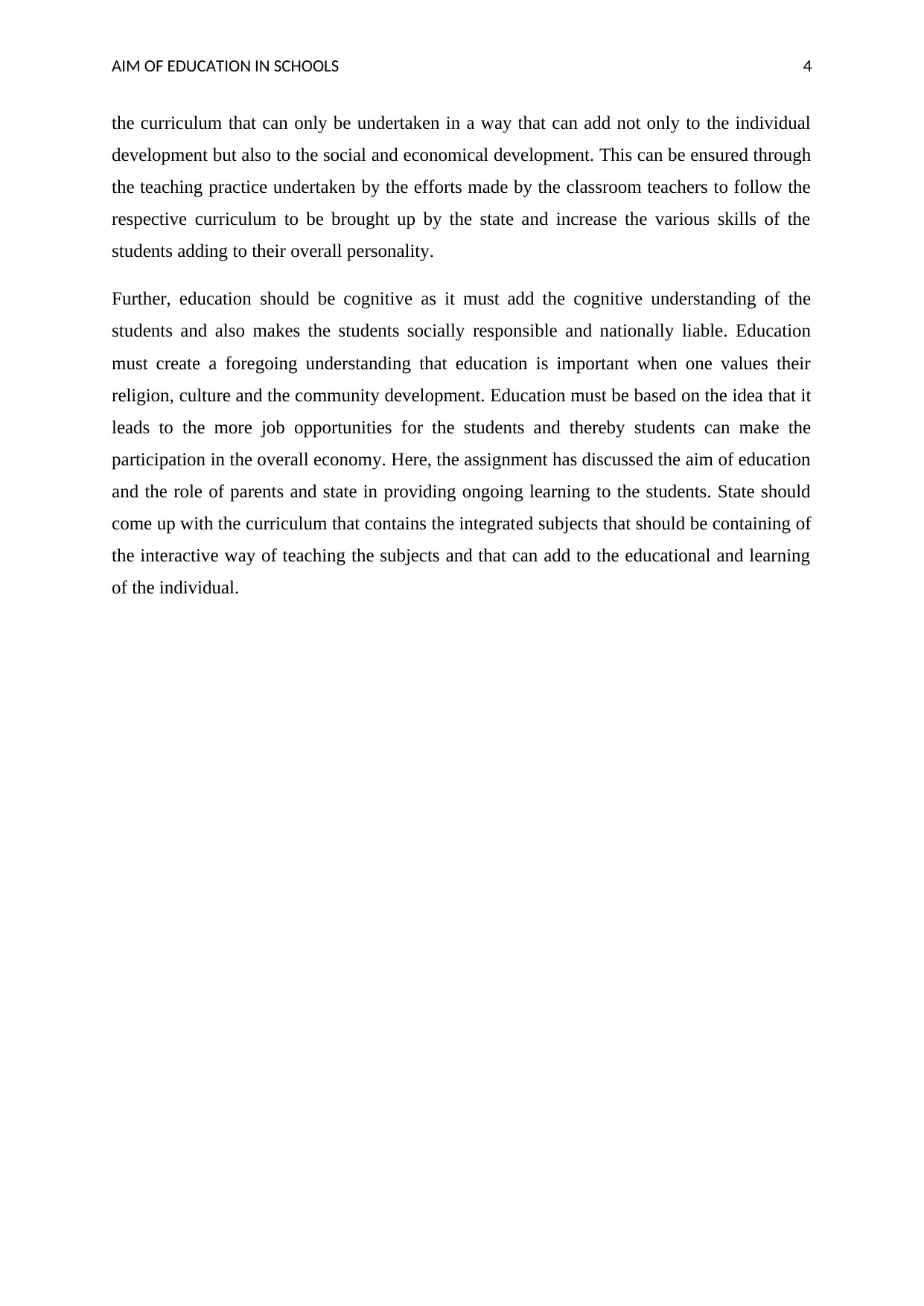
AIM OF EDUCATION IN SCHOOLS 4
the curriculum that can only be undertaken in a way that can add not only to the individual
development but also to the social and economical development. This can be ensured through
the teaching practice undertaken by the efforts made by the classroom teachers to follow the
respective curriculum to be brought up by the state and increase the various skills of the
students adding to their overall personality.
Further, education should be cognitive as it must add the cognitive understanding of the
students and also makes the students socially responsible and nationally liable. Education
must create a foregoing understanding that education is important when one values their
religion, culture and the community development. Education must be based on the idea that it
leads to the more job opportunities for the students and thereby students can make the
participation in the overall economy. Here, the assignment has discussed the aim of education
and the role of parents and state in providing ongoing learning to the students. State should
come up with the curriculum that contains the integrated subjects that should be containing of
the interactive way of teaching the subjects and that can add to the educational and learning
of the individual.
the curriculum that can only be undertaken in a way that can add not only to the individual
development but also to the social and economical development. This can be ensured through
the teaching practice undertaken by the efforts made by the classroom teachers to follow the
respective curriculum to be brought up by the state and increase the various skills of the
students adding to their overall personality.
Further, education should be cognitive as it must add the cognitive understanding of the
students and also makes the students socially responsible and nationally liable. Education
must create a foregoing understanding that education is important when one values their
religion, culture and the community development. Education must be based on the idea that it
leads to the more job opportunities for the students and thereby students can make the
participation in the overall economy. Here, the assignment has discussed the aim of education
and the role of parents and state in providing ongoing learning to the students. State should
come up with the curriculum that contains the integrated subjects that should be containing of
the interactive way of teaching the subjects and that can add to the educational and learning
of the individual.
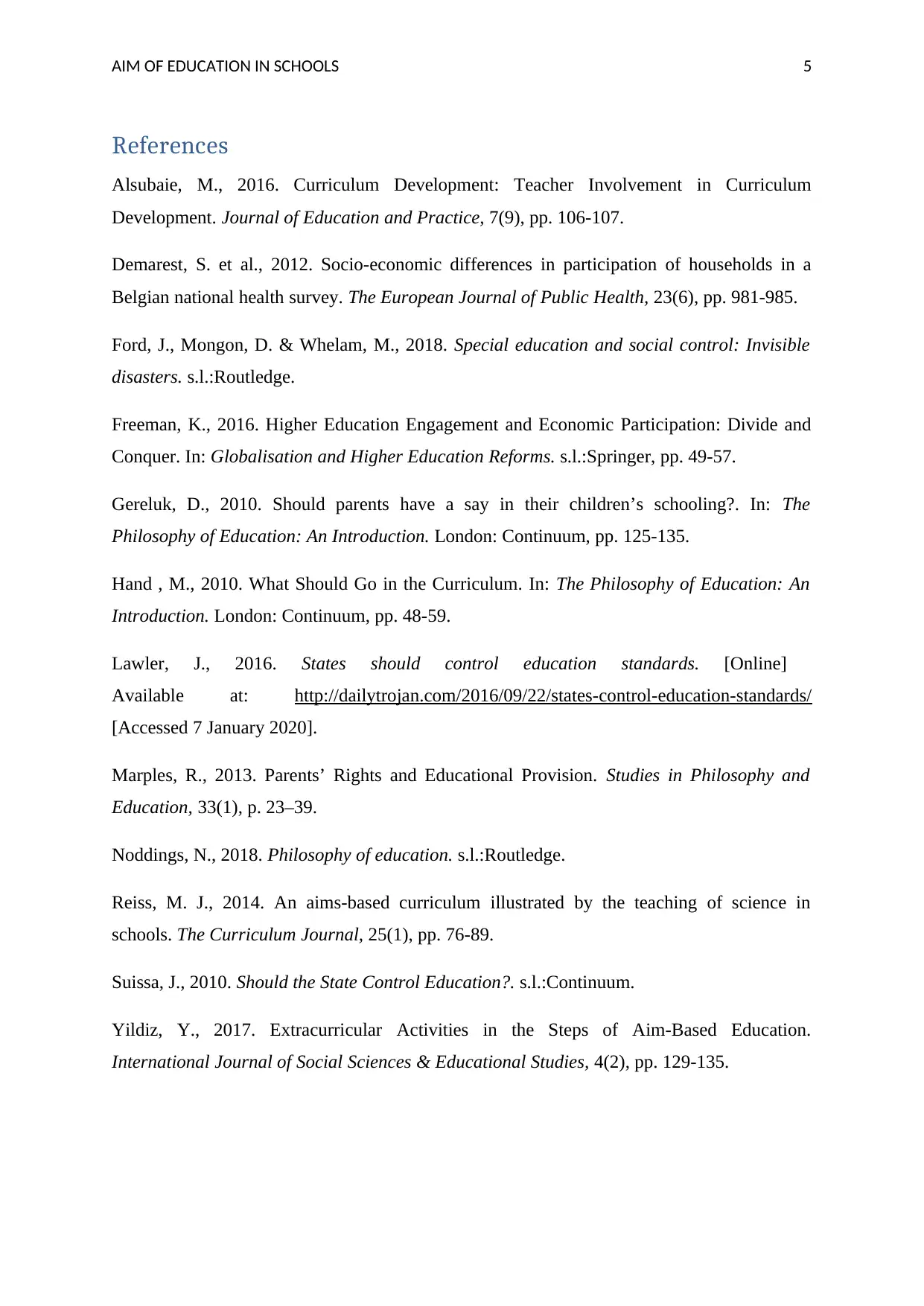
AIM OF EDUCATION IN SCHOOLS 5
References
Alsubaie, M., 2016. Curriculum Development: Teacher Involvement in Curriculum
Development. Journal of Education and Practice, 7(9), pp. 106-107.
Demarest, S. et al., 2012. Socio-economic differences in participation of households in a
Belgian national health survey. The European Journal of Public Health, 23(6), pp. 981-985.
Ford, J., Mongon, D. & Whelam, M., 2018. Special education and social control: Invisible
disasters. s.l.:Routledge.
Freeman, K., 2016. Higher Education Engagement and Economic Participation: Divide and
Conquer. In: Globalisation and Higher Education Reforms. s.l.:Springer, pp. 49-57.
Gereluk, D., 2010. Should parents have a say in their children’s schooling?. In: The
Philosophy of Education: An Introduction. London: Continuum, pp. 125-135.
Hand , M., 2010. What Should Go in the Curriculum. In: The Philosophy of Education: An
Introduction. London: Continuum, pp. 48-59.
Lawler, J., 2016. States should control education standards. [Online]
Available at: http://dailytrojan.com/2016/09/22/states-control-education-standards/
[Accessed 7 January 2020].
Marples, R., 2013. Parents’ Rights and Educational Provision. Studies in Philosophy and
Education, 33(1), p. 23–39.
Noddings, N., 2018. Philosophy of education. s.l.:Routledge.
Reiss, M. J., 2014. An aims-based curriculum illustrated by the teaching of science in
schools. The Curriculum Journal, 25(1), pp. 76-89.
Suissa, J., 2010. Should the State Control Education?. s.l.:Continuum.
Yildiz, Y., 2017. Extracurricular Activities in the Steps of Aim-Based Education.
International Journal of Social Sciences & Educational Studies, 4(2), pp. 129-135.
References
Alsubaie, M., 2016. Curriculum Development: Teacher Involvement in Curriculum
Development. Journal of Education and Practice, 7(9), pp. 106-107.
Demarest, S. et al., 2012. Socio-economic differences in participation of households in a
Belgian national health survey. The European Journal of Public Health, 23(6), pp. 981-985.
Ford, J., Mongon, D. & Whelam, M., 2018. Special education and social control: Invisible
disasters. s.l.:Routledge.
Freeman, K., 2016. Higher Education Engagement and Economic Participation: Divide and
Conquer. In: Globalisation and Higher Education Reforms. s.l.:Springer, pp. 49-57.
Gereluk, D., 2010. Should parents have a say in their children’s schooling?. In: The
Philosophy of Education: An Introduction. London: Continuum, pp. 125-135.
Hand , M., 2010. What Should Go in the Curriculum. In: The Philosophy of Education: An
Introduction. London: Continuum, pp. 48-59.
Lawler, J., 2016. States should control education standards. [Online]
Available at: http://dailytrojan.com/2016/09/22/states-control-education-standards/
[Accessed 7 January 2020].
Marples, R., 2013. Parents’ Rights and Educational Provision. Studies in Philosophy and
Education, 33(1), p. 23–39.
Noddings, N., 2018. Philosophy of education. s.l.:Routledge.
Reiss, M. J., 2014. An aims-based curriculum illustrated by the teaching of science in
schools. The Curriculum Journal, 25(1), pp. 76-89.
Suissa, J., 2010. Should the State Control Education?. s.l.:Continuum.
Yildiz, Y., 2017. Extracurricular Activities in the Steps of Aim-Based Education.
International Journal of Social Sciences & Educational Studies, 4(2), pp. 129-135.
You're viewing a preview
Unlock full access by subscribing today!
1 out of 6
Related Documents
Your All-in-One AI-Powered Toolkit for Academic Success.
+13062052269
info@desklib.com
Available 24*7 on WhatsApp / Email
![[object Object]](/_next/static/media/star-bottom.7253800d.svg)
Unlock your academic potential
© 2024 | Zucol Services PVT LTD | All rights reserved.




